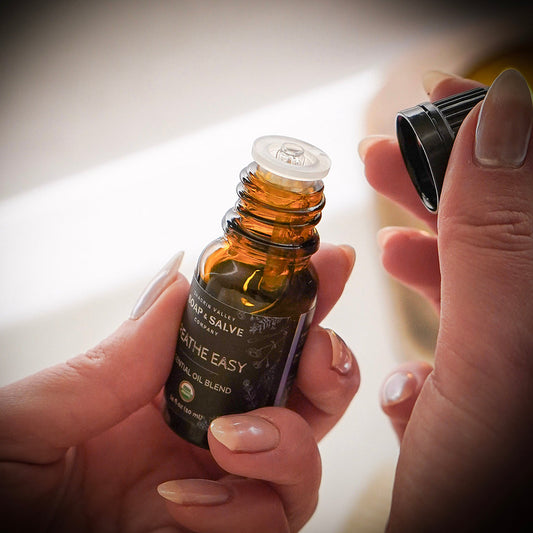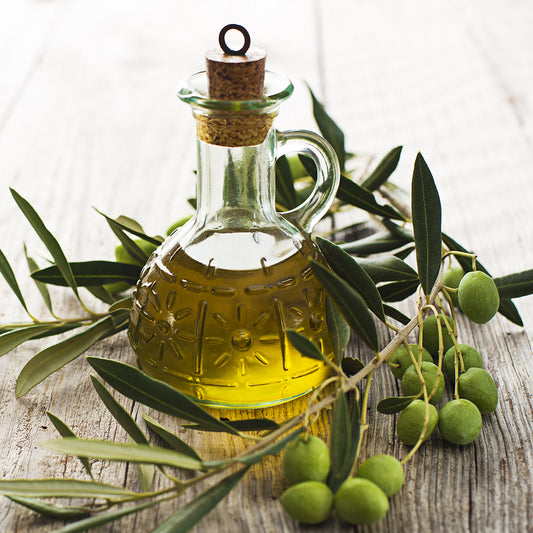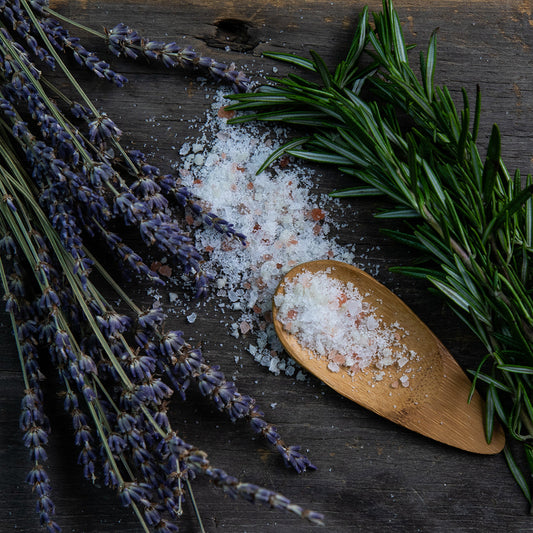Essential Oil Basics: A Guide To Dilution Rates
This is the second part of a two-blog series. The first blog discusses carrier oils.
What Does The Term "Neat" Mean?
Applying essential oils topically without dilution is a highly debated subject. Not only are essential oils much more potent than the botanicals from which they are extracted, but some are much more "potent" than others.
 If you go to a bar and order a "vodka neat," you will receive plain vodka poured straight from the bottle into an empty glass. There is nothing added, no water, no ice, and no little umbrella.
If you go to a bar and order a "vodka neat," you will receive plain vodka poured straight from the bottle into an empty glass. There is nothing added, no water, no ice, and no little umbrella.
When it pertains to essential oils, a “neat" application means the essential oil or essential oil blend is applied directly to the skin without being diluted in a carrier oil.
Thus, choosing not to dilute essential oils when using them topically (on the skin) is called using them “neat.”
Applying undiluted essential oils can potentially cause skin irritation and even sensitization.
Due to their high concentration, the general consensus among certified aromatherapists is that you should not apply undiluted "neat" essential oils to the skin except under the supervision of a professional.
According to Robert Tisserand, a recognized authority in aromatherapy,
“Do not apply undiluted essential oils to your skin. It’s that simple. The most common adverse reaction, experienced by hundreds, possibly thousands of people every year, is a skin reaction, and the most common cause is using an undiluted essential oil..”
The book Essential Oil Safety, which Tisserand co-authored with Rodney Young has become an industry standard for safety guidelines.
For most body care formulations, it is recommended that essential oils make up no more than 2% of your total end product weight or volume.
Unfortunately, the information about proper dilution rates is often ambiguous and contradictory.
Factors To Consider When Diluting Essential Oils
When deciding the proper dilution for a single essential oil, an essential oil blend, or any product containing essential oils there are a few main factors that need to be considered.
 Which essential oil or oils are being used? Since not all essential oils are equal in potency, each oil has a different maximum percentage that can be used in skincare products before you risk skin irritation This is called the maximum recommended dilution rate.
Which essential oil or oils are being used? Since not all essential oils are equal in potency, each oil has a different maximum percentage that can be used in skincare products before you risk skin irritation This is called the maximum recommended dilution rate.
These maximum dilution rates are based on the chemical composition of each essential oil. Since individual essential oils often have different safe dilutions for skincare products, it is important to research the proper dilution for each essential oil. For example, so-called “hot” essential oils like Cinnamon, Clove Bud, and Oregano will require a much larger dilution than others.
How is the final product being used on the skin? All essential oils are not the same. It is important to research the basic properties of each oil in a recipe to ensure that they are appropriate for the intended use of the final product. Some essential oils are not recommended for use on the skin even if diluted.
Some good questions to ask would include: Does the product remain on the skin after application, such as a body cream? Is the product readily washed off like soap? Is it generally applied to small localized areas like perfume or a spot treatment oil?
 Where is the final product being used? For example, is the product being used on the face, the lips, the whole body, or a small localized area?
Where is the final product being used? For example, is the product being used on the face, the lips, the whole body, or a small localized area?
According to the Tisserand Institute, the following dilution rates are suggested based on usage.
- Facial cosmetics: 0.2-1.5%
- Body massage: 1.5-3%
- Bath & body products: 1-4%
- Spot treatment for specific problems or targeted application: 4-10%
As you research dilution rates based on usage you will find a lot of information on the internet and in books but you will also discover a lot of inconsistencies. I would suggest that you find a trusted source and always start small. Remember with essential oils a little goes a long way!
Here is an example of how the three factors above can work together.
For instance, some essential oils can cause a photosensitive skin reaction when exposed to sunlight. These oils can be safely used when diluted at or below the maximum recommended dilution rate.
However, if you chose to make a more concentrated blend then how, where, and even when the product is being used becomes extremely important.
If you are making products or using essential oils for yourself or your family you should consider a few more factors, including age, health conditions, medications, and skin sensitivities. Some people are also very sensitive to certain scents, especially those with allergies.
A Note About Essential Oil Use in the Bath
So you have had a long day and want to melt your troubles away in a warm relaxing aromatic soak. You may think that you can create your relaxing bath by simply adding some drops of your favorite essential oil or blend directly into the bathwater. It seems to make sense since there is a lot of water in which to dilute the essential oil.
 However, there is one major problem with this plan, essential oils do not mix with water or in water-based liquids like hydrosols, milk, or aloe.
However, there is one major problem with this plan, essential oils do not mix with water or in water-based liquids like hydrosols, milk, or aloe.
When mixed with water the molecules of the essential oil will float in tiny droplets on the surface (think of oil droplets on the surface of the water).
Those droplets of essential behave like undiluted essential oils on your skin and can cause irritation. So please do not simply pour undiluted essential oils into your bathtub!
Instead, create an aromatherapy bath oil using your favorite carrier oil and a skin-safe dilution of essential oils. When using bath oil always take care as your bath may become slippery.
Calculating Dilution Rates
Once you have found a carrier oil that you like, you can begin to dilute essential oils according to the proper dilution ratio needed. Remember, start small!
When calculating dilution rates it is important that all essential oils must be counted together. For example, if the total dilution should be 2%, that means 2% total of all the essential oils used in that product, not 2% of each oil.
Although there is some wiggle room since the dilution numbers can vary based on the factors mentioned above, for most body care formulations it is recommended that essential oils make up no more than 2% of your total end product weight or volume.
Two percent equals about 12 - 18 drops per ounce (30 ml) of carrier oil depending on which dilution chart you use.
How to Use an Essential Oil Dilution Chart
As you can see from the example chart taken from the Tisserand Institute, dilution chart percentages are based on the number of drops of essential oil to use per a small amount of carrier oil.
The setup of most dilution charts is fairly standard. There are three pieces of information available
- the amount of the carrier oil you are using (indicated by the green bottles at the bottom of the Tisserand chart)
- the total percentage of essential oil you want in your carrier oil (on the left)
- the number of drops of essential oil needed to obtain that percentage.
So let’s look at the dilution chart.
In my first set of examples, we are keeping the percent of the essential oil the same but increasing the amount of carrier oil.
Example 1: If you want to use 10 ml of carrier oil and you want a 2% dilution, then you would need to use 6 drops.
Example 2: If you want to use 30 ml (1 oz) of carrier oil and you want a 2% dilution, then you would need to use 18 drops.
In the second set of examples, we are keeping the amount of carrier oil the same but increasing the percent of the essential oil by increasing the drops.
Example 1: If you want a 2% dilution in 20 ml of carrier oil then you would need to use 12 drops.
Example 2: If you want a 3% dilution in 20 ml of carrier oil then you would need to use 18 drops.
All Dilution Charts Are Not the Same?
Unfortunately, that is true! When researching dilution charts you will discover inconsistencies. You may be wondering why there is conflicting information.
Dilution charts are usually developed with the home crafter in mind. When consumers buy a small bottle of essential oil their goal is usually to use it in a diffuser or to create a small amount of product for home use.
When working with small quantities of essential oils for your own personal use, the easiest way to measure is by the drop.
If you check a measurement conversion calculator online it will usually indicate that 20 drops equal 1 ml.
The Tisserand Institute dilution chart shown works on the assumption that there are 30 drops per ml, not 20. They published their rationale in the article "How big is a drop?"
However, since drop sizes are neither precise nor standardized is that really true?
We are a curious bunch and decided to do our own little experiment. Five different people used four different style droppers and three different essential oils.
We used a scale in order to determine how many drops we would need to equal one gram which is about equivalent to one milliliter (at least for water).
Obviously, this was far from a scientific study but the numbers we observed were quite diverse ranging from 18 drops to 38 drops of essential oil needed to equal 1 gram (1 ml).

The drop "size" of one essential oil may be bigger or smaller than another depending on the viscosity and temperature of the oil as well as the size and type of the dropper or orifice reducer.
Although measuring by the drop is not very accurate, it is fine for creating small topical blends and recipes for your own personal use.
While some dilution charts, like the one from the Tisserand Institute, are based on 30 drops per ml, others are based on 20 drops per ml. That is why there are inconsistencies.
When dealing with small amounts, it is difficult to be very accurate. So, for personal use, you are better off erring on the side of using too little essential oil rather than too much!
There are also charts using teaspoons and tablespoons instead of ml for the amount of carrier oil. If you like working with teaspoons and tablespoons here are some approximate values:
- 5 ml = 1 teaspoon
- 10 ml = 2 teaspoon
- 15 ml = 3 teaspoon (1 tablespoons)= 1/2 oz
- 20 ml = 4 teaspoon
- 25 ml = 5 teaspoon
- 30 ml = 6 teaspoon (2 Tablespoons) = 1 oz
We do not use drops when formulating essential oil products at Chagrin Valley. Since we deal with larger quantities, the most accurate and precise method of measuring is by weight, not by drop or volume. Our measurements and calculations are always done by weight using an accurate scale.
Essential Oil Dilution Rates at Chagrin Valley
At Chagrin Valley, our body care products made with essential oils, like creams and body oils, that remain on the skin have a dilution rate of less than 2%.
The actual rate for each product depends on the oils used and the usage. Although people enjoy the scents in skincare products, their main function tends to be moisturizing not aromatherapy.
Except for our Whipped Squalane Face & Eye Mousse which contains organic lavender at a dilution rate of less than 0.05%, our facial moisturizers do not contain essential oils.
 For our scrubs, which are considered "wash-off" products, the dilution is still less than 1.0%.
For our scrubs, which are considered "wash-off" products, the dilution is still less than 1.0%.
Aromatherapy Roll-On are a bit different. They are generally applied sparingly to small localized areas and their function IS aromatherapy.
In order to experience the benefits of these aromatic products, we need to use a higher proportion of essential oils. There seems to be a general consensus that for spot use of an aromatherapy roll-on, a dilution of up to 5% is safe for adults and still allows for gentle aromatherapy.
We have been making essential oil blends for our own personal use for about 4 years.
After almost a year of testing variations of Aromatherapy Roll-On formulations on friends, family, and customers with a variety of skin types and sensitivities we chose a dilution of 4.5%.
Although our sample was small, our test subjects enjoyed the strength of the aromas and experienced no skin irritations or sensitivities.
Conclusion
Applying essential oils directly to your skin without proper dilution significantly increases the risk of irritation or adverse reactions.
People using essential oils in topical treatments should always use carrier oils, follow the proper dilution guidance, and always use the lowest dilution possible that gives you effective results.
 Unfortunately, many of us have become accustomed to the long-lasting, heavily scented commercial fragrances found in room fresheners, creams, soaps, perfumes, etc., which are scented primarily with synthetic ingredients.
Unfortunately, many of us have become accustomed to the long-lasting, heavily scented commercial fragrances found in room fresheners, creams, soaps, perfumes, etc., which are scented primarily with synthetic ingredients.
If you are new to essential oils and are used to strongly scented products, the aroma from a gentle essential oil diffuser or a skincare product formulated with a 2% dilution may seem very weak and barely aromatic at first. However, over time your nose will adjust and learn to appreciate the subtleties of pure essential oil products.
Just remember that essential oils are extremely concentrated and less is always more. Treat essential oils with the same respect as traditional medicines you might use.
All that being said, it is a good idea to do a Patch Test before using any new products, especially if you have sensitive skin. A skin patch test, recommended for the first-time use of anything new to your skin, allows you to determine how your skin reacts to a particular oil or product before general use.

Photosensitivity and Citrus Essential Oils
Why We Use Only Real Plant Essential Oils?
How Essential Oils Are Extracted
Essential Oil Basics: A Guide To Carrier Oils
How to Diffuse Essential Oils for Personal Use
How To Use Roll-On Aromatherapy
How To Do A Simple Allergy Patch Test
The information above pertains to healthy adults. We do not provide information on the safety of essential oils during pregnancy or for use in Children because the available information is often contradictory. If you are interested in using essential oils during pregnancy or with young children please do your own research and be sure to consult your doctor, midwife, or health care professional before use.
The statements regarding health-related benefits of essential oils have not been evaluated by the Food and Drug Administration and are in no way intended and should not be construed as medical advice to diagnose, treat, cure, or prevent any disease or health condition.










